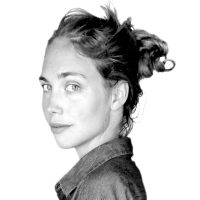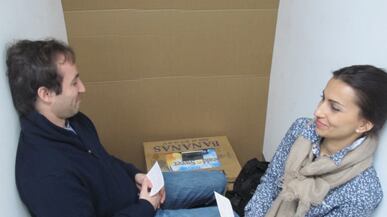The sterile cellar at Allegra LaViola Gallery on New York’s Lower East Side is serving up a new kind of art, combining people and food. Puritans, gluttons, and hedonists mingle around phallic parsnips, unripe bananas, and potato skins in artists Phoebe Joel and Joy Tomasko’s evolving exhibition Be Meat and Drink. The multisensory performances engage viewers’ perceptions of food—and one experiment even tries to hook participants up with one another.

Phoebe Joel’s DIET = (meat + potatoes) + food chemical challenges performance focuses on the connection between pleasure and food consumption in modern culture. In an effort to subvert these transitory experiences, Joel went on a strict diet for six weeks before the show’s opening, working with a team of allergists at Sydney’s Royal Prince Alfred Hospital to determine what foods she should and shouldn’t eat. She cut out amino acids and other slightly toxic chemicals found in many foods we consume every day. Then, beginning with the exhibition’s opening on March 26, she reintroduced these chemicals back into to her body in pill form and began monitoring their physical effects. Her body became a mutating “canvas,” manifesting reactions such as hives, rashes, swelling, and stomach pains.
Roughly three weeks into the experiment, Joel’s body is still in flux. Visitors have the opportunity to share a 30 minute meal with the artist during which they can ask questions and learn more about her color-coded diet. “The food I serve has to adhere both to specific colors and to my diet. I use these colors as another way of reducing things to a very simple state,” Joel explains.
Sharing the same space is Tomasko’s collateral piece, In Vivo / Ex Vivo / Id Visu, which involves a blind pairing of two strangers set up through the conceptual matchmaking experiment Knish Konnection. Instead of using one of New York’s many decadent restaurants as a venue for blind pairings, Knish Konnection hosts dates in the confined, quiet, white-walled basement of Allegra LaViola’s gallery, paring down the dinner menu to an inexpensive, simple food: the traditional Yiddish knish. “The experiment is in part a commentary on New York. There’s so much noise in this city, and we’re trying to take some of that away,” Joel says.
Then again, no one wants too much silence on a blind date. There’s usually no way of knowing whether the romantic chemistry will be there from the beginning—and Tomasko’s blind pairing is no different, except a third party is involved. Tomasko plays the role of Cupid in a lab coat.
Pairs are selected based on a Knish Konnection questionnaire asking for, among other things, your name, occupation, and Zodiac sign. It asks the wannabe couples to “pick one” from a variety of artists, books, entertainers, politicians, animals, foods, and flavors. (Surely, people who love chocolate might also love each other.) Applicants must also submit headshots and full-body pictures. It’s not entirely dissimilar from a profile you might display on OkCupid. But in Tomasko’s matchmaking experiment, the all-knowing artist chooses “a unique pairing designed to surprise your palate with flavors that linger.”
She orchestrates dates using chemical interactions to speed up the matchmaking process, bringing her subjects together in a hole-in-the-wall space where she conducts various experiments to make daters communicate in unexpected ways. She gives daters topics to discuss or avoid; she takes hair samples to examine their biological makeup; she serves them food and forces them to interact on a sensory level.
Sound intriguing? The artist’s message is meant to drip with innuendo. Food and pleasure often go hand-in-hand. Think of that infamous scene from 9½ Weeks when Mickey Rourke seductively teases Kim Basinger. She closes her eyes, opens her mouth, and allows him to feed her cherries, strawberries, and Champagne. Dessert never looked so good. It doesn’t get quite that heated in the art space. “We strip away a lot of things, but there’s no stripping of clothes,” says the artist. “We serve the knish with a tiny fork and spoon. It’s not like eating oysters, which is sexy. But you’re still digging into something.”
People always go into blind dates with expectations, and Knish Konnection’s blind pairings almost put more pressure on the daters to have an interesting experience. No one knows exactly what they’re getting into, but many come to the gallery with fantasies, hopes, or anxieties. “I had some guy ask me what the dress code was,” Tomasko says. There’s a voyeurism inherent in her matchmaking experiment. Daters are trying to gauge their attraction to one another, but a third party is watching their every move.
And so here is where I admit that I participated in Tomasko’s blind pairing performance with wide-eyed expectations. It started out promisingly enough: Throughout our encounter, which played out over a scripted conversation on notecards given to us by the artist, it was clear my date and I had similar interests, thought processes, and personality traits. We shared a practically identical childhood memory, had the same sleeping patterns, and found sentimental value and comfort in related subjects. But a crucial element was missing from our interaction: chemistry. The artist’s careful planning didn’t turn out to be helpful—at least in my case. Interestingly enough, the lack of chemistry was reflected in our taste buds—my date turned his nose up at the potato and mushroom knish that we shared, while I devoured my portion and requested more. In the end, we did not make a knish love konnection.
Despite all the doughy, potato-filled treats I’d consumed, I left the gallery feeling hungry and perplexed. Had I just been the object of a science experiment, the victim of a bad date, or an active participant in a performance art-piece? Conceptually, Tomasko’s scripted blind pairing was a meticulously crafted work of art. Yet the artist was wearing a lab coat and collecting data, and her exhibition functioned in part as a dating service. Digging into my parting gift of knish gelato, I decided to abandon my literal interpretation of the blind pairing. It was a conceptual matchmaking experiment after all. And at least at the end of this bad date, my perfect match was a snack—and a good story to tell.
Be Meat and Drink will stage its last performance on April 16 at Allegra LaViola Gallery. For this final show, attendants are asked to bring a bowl and a spoon. Email potato@knishkonnection.com to make a reservation.
Lizzie Crocker is an editorial assistant at The Daily Beast. She has written for NYLON, NYLON Guys, and thehandbook.co.uk, a London-based website.





